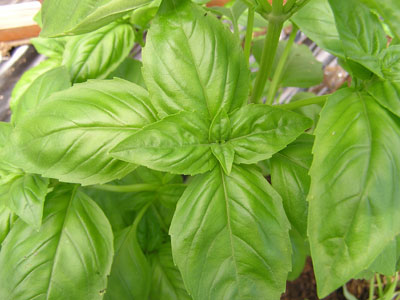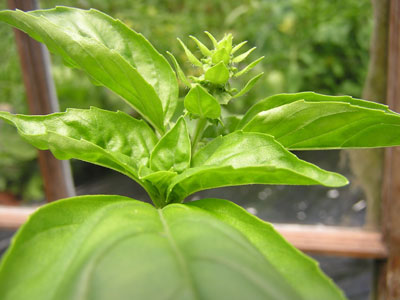 |
| Basil can be harvested throughout the summer and into fall to make pesto. Freeze some pesto in ice cube trays for winter use. English photo. |
By Jean Ann Pollard
“This [basil] is the herb which all authors are together by the ears about and rail at one another (like lawyers).”
– Nicholas Culpepper, The English Physitian or an Astrologo-Physical Discourse of the Vulgar Herbs of this Nation, 1653.
Although summer may end in Maine with September, basil plants remain thick and flourishing until frost turns them black. Before that, gardeners prize its special flavor in everything from soups to pesto – and no wonder. Basil has a long history of culinary use from the ancient Greeks to the Romans, as mentioned by Dioscorides, Theophrastus and other transcribers, but it took a long time traveling to New England.
According to Tom Stobart in Herbs, Spices, and Flavourings, Ocimum “probably came from India to Europe overland via the Middle East. It arrived in Britain in the sixteenth century and reached America in the seventeenth, so its use in the West is comparatively recent.”
In India, reports Lesley Bremness, editor of Herbs, “basil is held in reverence as a plant imbued with divine essence, and therefore the Indians chose this herb upon which to swear their oaths in court. Basil was found growing around Christ’s tomb after the resurrection, so some Greek Orthodox churches use it to prepare the holy water, and pots of basil are set below church altars.”
 |
| When basil plants begin to flower, pinch them back just below the flower so that they continue to grow vegetatively. English photo. |
Many varieties of this favorite herb exist, including bush basil, a South American native; but before 1848, says Helen Noyes Webster, “when DeCandolle made his long list of Ocimum species and varieties from all over the world,” early herbalists seemed to content themselves with three “Sortes” — the Great Basil, the Medium Basil, and the Lesser Basil. “This naive classification,” she adds, “is common in herbals up to the eighteenth century. Exactly to what modern species some of these might be compared we can only conjecture.”
In Herbs for Use and for Delight, she noted that the herbals of Tusser, Culpepper and Coles (“which contained all that was necessary for the housewife to know about … herbs”) were almost as precious to early American settlers as the Bible. Sweet basil was one of those mentioned before 1806 in Colonial garden records.
Whatever species we choose to identify or grow today, Ocimum, either fresh or dried, is a kitchen delight par excellence. Maine herbalist Madeleine Siegler of Monks Hill Herbs suggested in her 1980 pamphlet, “Growing Herbs in New England,” that “Sweet Basil (Ocimum basilicum) dries well, “if your seed is “lettuce leaf variety.” Or, she said, you may prefer “to chop and freeze the leaves, as they tend to turn black during drying. Basil tea is reputed to be a tranquilizer.”
Webster offered a recipe using dried curly basil. “Its large wrinkled leaves and short spikes of crowded flowers make, when dried, the best herb pepper when in combination with costmary, savory, and marjoram.”
Perhaps world traveler Tom Stobart had the best idea. “Where I lived on the Italian Riviera the common snack consisted of a crusty roll split and filled with sliced tomato, salt, olive oil, and a few leaves of fresh basil – no butter of course – just squashed to make the oil and juice impregnate the bread.”
But the most delicious use of all, he added, “is in pesto Genovese, which in various forms is found all along the Riviera coast from Genoa to Provence. The basis is always basil, with garlic, salt, olive oil, Parmesan and sardo (hard Sardinian sheep’s milk) cheese, pine nuts and often skinned walnuts – all pounded together to a thick sauce.”
Pistou in Provence is used to season soups. In Italy, pesto with plenty of olive oil makes a sauce for spaghetti or trenette. Here is an easy recipe for making pesto.
Pesto
(for 1 pound of cooked pasta)
In a blender or food processor, place:
1 to 2 cups of freshly picked, rinsed, dried basil leaves
2 to 3 cloves garlic, crushed
a little sea salt
freshly ground black pepper
1/4 to 1/2 cup extra-virgin olive oil
Process to a paste.
Add:
1/2 cup pine nuts (or walnuts)
3/4 cup grated Parmesan and/or Romano or Pecorino cheese
Continue processing until thick and creamy.
Serve at room temperature with pasta, vegetables or even on toast!
You can adjust the amount of oil, basil leaves and cheese to suit your fancy.
Basil-flavored vinegar is fine for dressing salads.
Basil in Vinegar
Fill a large, wide-mouthed glass jar with:
about 2 ounces fresh basil leaves
Cover with:
1 pint rice vinegar
Allow to steep for two to three weeks; then strain off the vinegar into bottles.
Put a fresh sprig of herb into each bottle and cap.
Use when mixing up any vinaigrette.
Bibliography
Bremness, Lesley, ed. Herbs, The Reader’s Digest Assoc., Inc., N.Y., 1990.
Siegler, Madeleine, “Growing Herbs in New England,” 1980 pamphlet.
Stobart, Tom, Herbs, Spices, and Flavourings, Penguin Books, 1970.
Webster, Helen Noyes, Herbs for Use and for Delight, an anthology from The Herbalist, a publication of the Herb Society of America, Dover Publications, Inc., N.Y. 1974, ed. Daniel J. Foley.
